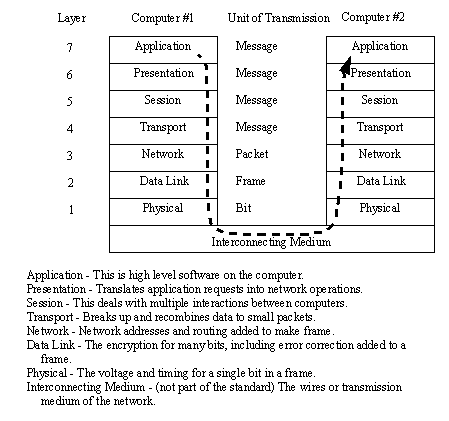
The Open System Interconnection (OSI) model in Figure 27.1 The OSI Network Model was developed as a tool to describe the various hardware and software parts found in a network system. It is most useful for educational purposes, and explaining the things that should happen for a successful network application. The model contains seven layers, with the hardware at the bottom, and the software at the top. The darkened arrow shows that a message originating in an application program in computer #1 must travel through all of the layers in both computers to arrive at the application in computer #2. This could be part of the process of reading email.

Figure 27.1 The OSI Network Model
The Physical layer describes items such as voltage levels and timing for the transmission of single bits. The Data Link layer deals with sending a small amount of data, such as a byte, and error correction. Together, these two layers would describe the serial byte shown in the previous chapter. The Network layer determines how to move the message through the network. If this were for an internet connection this layer would be responsible for adding the correct network address. The Transport layer will divide small amounts of data into smaller packets, or recombine them into one larger piece. This layer also checks for data integrity, often with a checksum. The Session layer will deal with issues that go beyond a single block of data. In particular it will deal with resuming transmission if it is interrupted or corrupted. The Session layer will often make long term connections to the remote machine. The Presentation layer acts as an application interface so that syntax, formats and codes are consistent between the two networked machines. For example this might convert ’\’ to ’/’ in HTML files. This layer also provides subroutines that the user may call to access network functions, and perform functions such as encryption and compression. The Application layer is where the user program resides. On a computer this might be a web browser, or a ladder logic program on a PLC.
Most products can be described with only a couple of layers. Some networking products may omit layers in the model.